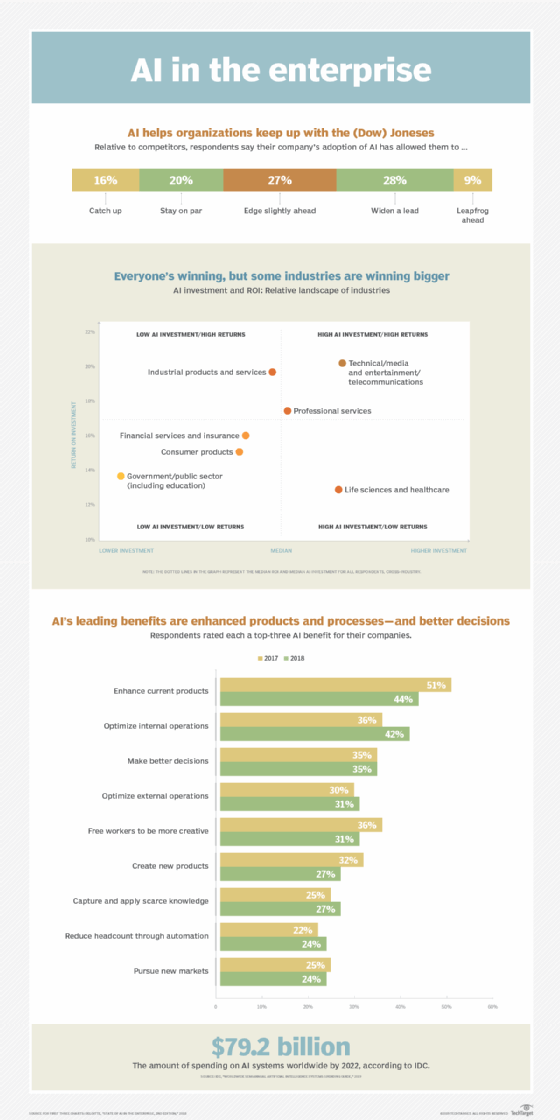AI in IT infrastructure transforms how work gets done
Cutting through the hype around AI has become a major job for IT leaders. Our in-depth guide on where and how to add AI to your IT infrastructure will help.
Technology providers are investing huge sums to infuse AI into their products and services. The industry press touts the gains companies stand to make by infusing AI in IT infrastructure -- from bolstering cybersecurity and streamlining compliance to automating data capture and optimizing storage capacity. AI, we are told, will make every corner of the enterprise smarter, and businesses that fail to understand AI's transformational power will be left behind.
The reality, as with most emerging tech, is less straightforward.
"Despite AI's potential to transform products and business processes, executives must not get caught up in the hype," cautioned Ashok Pai, vice president and global head of cognitive business operations at Tata Consultancy Services. "Starting out with AI means developing a sharp focus."
Before IT and business leaders fund AI projects, they need to carefully consider where AI might have the greatest impact in their organizations. They must align AI investment to strategic business priorities such as growing sales, increasing productivity and getting products to market faster. The choices will differ from company to company and industry to industry, Pai said. For example, manufacturing companies might decide that embedding AI in their supply chains and production systems is their top priority, while the services industry might look to AI for improving customer experience.
For most companies, AI projects will not resemble the multiyear, billion-dollar moonshots like the automotive industry's quest to develop a driverless car, Pai said. Instead, C-suite executives should prioritize and fund six-to-12-month short-term projects backed by a business case with clear goals and a potential return on investment. And they should understand that when embedding AI in IT infrastructure, failure comes with the territory.
"The key is to recognize failures quickly, cut your losses, learn from those failures and make changes to improve the chances of success on future AI projects," Pai said.
Not every business, to be sure, is dazzled by AI's celebrity status. Many businesses, in fact, are being smart when it comes to adopting AI automation tools, said Lyndsay Wise, director of market intelligence at Information Builders, an IT consultancy.
 Lyndsay Wise
Lyndsay Wise
"Instead of buying into the hype, they are asking critical questions for garnering the strongest ROI, resulting in a delay in broad adoption of AI," Wise said. A 2019 Gartner survey on CIO spending found that only about 37% of enterprises have adopted AI in some form, up from about 10% in 2015.
Wise said many organizations are realizing that strong data management is a core foundation for predictive analytics and AI technology, and they are focusing first on getting their data house in order. Others have realized they don't have the pool of data necessary to make the most of predictive technologies and are investing in building the right data streams, she said.
Companies in the thick of developing a strategy for incorporating automation and AI in IT infrastructure will need solid grounding in how AI technologies can help them meet business objectives. What follows is an in-depth look at the IT systems and processes where automation and AI are already changing how work gets done in the enterprise.
Automation and AI in data capture
AI technologies are playing a growing role in capturing different types of data critical to the business today, and in identifying data that could be used to improve the business in the future. Most voice data, for example, is typically lost or briefly summarized today. A new generation of AI transcription tools promises to not only make it easier to document these processes but also capture more analytics for understanding call center interactions, business meetings and presentations.

Documents still play an important role in transacting business, despite the growth of new application interfaces. For example, the U.S. Bureau of Labor reports that businesses spend over $130 billion a year on keying in data from documents. New tools for extracting data from documents could help reduce these costs.
Increasingly sophisticated optical character recognition (OCR) technology and better text mining and speech extraction capabilities using natural language processing allow systems to rapidly digitize vast quantities of documents and texts. This is the industrialization of data capture -- for both structured and unstructured data. These tools automate sorting, classification, extraction and eventual disposition of documents.
Senthil Kumar, a partner at Infosys Consulting, said bigger breakthroughs in data capture are in the offing.
 Senthil Kumar
Senthil Kumar
"The future of data capture systems is in being able to mimic the human mind -- in not just industrialized data capture, but in being able to deal with ambiguous data and interpret the context quickly," he said.
Although OCR technology has become more sophisticated and much faster, it is still largely limited by template-based rules to classify, extract and validate data. "These tools lack the magical qualities of a human mind, which is basically an intuitive assimilation, coordination and interpretation of complex data pieces," Kumar said. Complex business scenarios require systems that can make sense of a document much like humans can. He believes this is where machine learning and deep learning show the most promise for improving data capture.
Machine learning models are immensely scalable across different languages and document types. They require some initial effort to build high-quality training models and entity-recognition techniques, but once that foundation is built, such techniques are faster, better and far more contextual than the templatized approach. "Successful organizations aren't built in a template-driven world," Kumar said.
One interesting data capture application is to use machine learning models to track the flow of information in the company, Kumar said. Machine learning could be used, for example, to identify a company's top experts on difficult topics, giving other workers ready access to that store of knowledge. Analysis about the flow of information could also help management prioritize its internal messaging or improve the dissemination of information through the ranks.
5 ways AI improves data capture
Enterprises are using AI to do the following for data capture:
- Process and analyze millions of invoices across multiple vendors, locations and geographies to improve verification of submissions, rebates management and reconciliation.
- Decompose and extract context from complex documents, such as legal briefings, multilanguage research papers, architecture blueprints and land surveys.
- Evaluate relevance for search engine optimization and to monetize searches.
- Assess social content for relevance and preferences and to monitor for hate speech and misinformation.
- Label images and videos for entity recognition (annotation), helping users query with natural language.
Source: Senthil Kumar, partner, Infosys Consulting
AI and automation in HR
In HR, embedding AI in IT infrastructure is streamlining the analytics companies use to vet résumés, analyze the performance of new hires, automatically provision IT resources needed by new hires and improve the delivery of training services.
"The average résumé is looked at by a recruiter for only six seconds, creating a significant margin for missed opportunities in the talent recruitment process," said Aarti Borkar, formerly with IBM Watson's talent and collaboration group, and now vice president of IBM security.
AI can take that candidate's résumé and develop a robust profile of skills and proficiencies, allowing recruiters to make a more accurate assessment in the same six seconds. AI can also boost retention by enabling better and more personalized career-development programs.
But even more important than improving efficiencies in HR, AI has the capability to mitigate the natural human bias in the recruiting process and create a more diverse workforce. "There is significant evidence to show that greater diversity in a company drives greater business outcomes because, in practice, opposing viewpoints cancel out blind spots," Borkar said.
Doug Rose, an AI consultant and trainer and author of Artificial Intelligence for Business, expects to see businesses use AI to improve employee well-being and engagement. These tools look for patterns and then try to determine the happiness of employees. This could make it easier for HR to run small experiments to improve well-being, such as having employees work from home or providing them with specific training. The algorithm could then assess if there's an improvement. Rose said these newer AI engagement tools can help companies tweak their policies in real time to lower turnover and improve their organizational culture.
"Often, employers can make just a few marginal improvements to increase productivity and give each employee a better experience," he said.
 Kate Lister
Kate Lister
HR teams are also likely to be on the front lines of another consequence of using AI in the workplace: addressing employee fears about automation and AI. Kate Lister, president of Global Workplace Analytics, an HR research and consulting firm, said she believes businesses need to focus on how automation and augmented intelligence will make work easier for many.
"[Employees] should think of the collective AI technologies as digital assistants who get to do all the drudge work while the human workforce gets to do the part of the job they actually enjoy," Lister said. In addition, the drudge work will be done better, thanks to AI automation.
Still, HR needs to be mindful of how these digital assistants can run amok. For example, if a desk sensor detects that "Sally is rarely at her desk," Lister said, it might conclude she does not need a desk or that she's slacking off when in fact she camps out in the conference room because the Wi-Fi is better there.
"While much of what computers do has to do with big data that's been anonymized, 'little data' about Sally, in particular, can give rise to security, privacy and ownership issues," Lister said.
How NTT is automating security
 Steve Williams
Steve Williams
Steve Williams, CISO for NTT Data Services, said he has focused on using AI to automate the systems integrator's traditional tier 1 security operations work in order to address the shortage of skilled security professionals, standardize on a higher level of quality and keep pace with the bad guys who are starting to use AI to improve their attacks.
This strategy has helped improve staff retention by allowing Williams' team to focus on more engaging projects. The AI-enabled approach also helps reduce human error since it decreases deviation from standard operating procedures. Automation and AI can also reduce the amount of time it takes to troubleshoot a problem compared with finding the right human, who then has to remember how he or she solved it last time.
Williams also believes that AI makes it easier to keep pace with the recent hacks of two-factor authentication safeguards that stem from fully automated attack workflows.
AI automation in applications
Major CRM, ERP and marketing players are starting to create AI analytics tiers on top of their core platforms. The AI layers will make it easier to surface data from these platforms and incorporate data into other applications, creating better customer experiences through better response time and mass personalization.
Infusing AI into ERP can also help enterprise leaders make better procurement decisions, faster. Forrester Research predicts this added capability could eventually lead to a new generation of business clouds more attuned to the needs of traditional enterprises than those of existing cloud leaders.
For example, Adobe recently launched the Adobe Experience Platform to centralize data across its extensive marketing, advertising and creative services. The tool promises to break down data silos and make it easier for brands to understand their customers and make data actionable by using AI and machine learning. SAP, Salesforce, Microsoft and Oracle have launched similar initiatives that make it easier to infuse AI into different applications running on their platforms.
 Pankaj Chowdhry
Pankaj Chowdhry
"[Business application vendors'] intimate knowledge of the data puts them in a great position to rapidly deliver customer value, and this will be one of the quickest and most successful ways for an enterprise to adopt AI," said Pankaj Chowdhry, founder and CEO of FortressIQ, a process automation tool provider. The early tools from these business clouds have focused on implementing vertical AI layers to help automate very specific business processes like lead scoring in CRM or supply chain optimization in ERP.
Chowdhry said the biggest challenge for companies is that most of these features are only available on the newest versions of a platform, and they don't play well with customizations. Also, the AI built on these platforms is heavily dependent on the quality of an enterprise's data. For example, many CRM databases contain duplicate customer records due to multichannel sales, customers changing addresses or simply from typos when entering customer details, said Colin Priest, senior director at DataRobot, an automated machine learning tools provider. But AI can also be useful in cleaning up the data by identifying these duplicate records, resulting in better customer service and regulatory compliance.
AI automation in security
Incorporating AI in IT infrastructure promises to improve security compliance and management, make better sense of data coming from a variety of sources to quickly detect incoming attacks and improve application development practices.
The low-hanging fruit for using AI-enhanced automation in security is in compliance management, said Philip Brown, head of Oracle cloud services at DSP, a managed database consultancy in the U.K.
"Enterprise IT still has a long way to go just to cover the basics of security compliance and management," Brown said. A typical enterprise might have a database estate encompassing 250 databases and a compliance policy with about 30 stipulations for each one, resulting in about 7,500 data points that need to be collected.
 Philip Brown
Philip Brown
It's not practical to collect all this data manually since it must be collected regularly to be of any value. Then it must be processed and scored, and remediation actions taken when security or compliance problems are discovered. "This is difficult to do without automation," Brown said, and without AI.
Brown observed that there are two ways to annoy an auditor. The first way is to tell them every instance in which you're not compliant. This will annoy auditors, but they will be happy you know where the gaps are. The second way is to tell them you have no idea how compliant you are, as you can't gather the data and process it. "Security automation is not just important in automatically fixing the issues but equally in capturing the data on a regular basis and processing it," Brown said.
AI also shows some promise in mining event data for anomalous patterns that may represent a security threat. But training these systems requires IT managers to maintain clean data sets to control what these systems learn.
 Jonathan Glass
Jonathan Glass
Security tool vendors have different strategies for priming the AI models used in these systems. But Jonathan Glass, cloud security architect for cloud consultancy Candid Partners, said caution is warranted when vetting these tools. He fears that hackers could anonymously prime them with maliciously crafted critical systems files, like the Windows kernel, which could cause the AI solution to block those files.
"AI and machine learning are great for identifying threats and patterns, but you should still let a human make the final call until you're 100% confident in the calls," Glass said. A security service that is automated with AI runs the risk of blocking legitimate users if humans aren't kept in the loop. A tool should only augment good security processes and should not be used to fully solve anything, he stressed.
Security issues are much cheaper to fix earlier in the development cycle. Software integrated development environment (IDE) plugins from providers such as Contrast Security, Secure Code Warrior, Semmle, Synopsis and Veracode embed security "spell checkers" directly into the IDE.
"But having actual security experts and peer code reviews will still be key, now and in the future," agreed Craig Lurey, CTO and co-founder of Keeper Security, a password management provider. AI doesn't understand the purpose of your software nor the mind of an attacker, so the human element is still vital for security, he explained. One use of AI in security that shows promise is to use AI automated testing and analysis for ensuring the underlying data is encrypted and better protected. But this will still require humans with a full understanding of the usage model and business case.
How Zillow uses AI automation to improve its data management
As data becomes richer and more complicated, it's impossible for human beings to monitor and manage all these massive data sets, said Steve Hsiao, senior director of data engineering at Zillow Group, the real estate service.
 Steve Hsiao
Steve Hsiao
Zillow is using AI in IT infrastructure to monitor and predict anomalous data scenarios, data dependencies and patterns in data usage which, in turn, helps the company function more efficiently. AI and automation are also being used for auto-scaling, intelligent query planning and cluster tuning, the process of optimizing the performance of a collection of servers used for running Hadoop infrastructure.
"Using AI is an effective way to identify data that's no longer being used, which we can then determine whether to offload to slower storage, compress or consider deleting," Hsiao said. AI techniques can also be used to tag statistics about data sets for query optimization. For example, Zillow uses an in-house AI system that detects anomalies to predict incorrect data or suspicious patterns of data generation.
Still, there are no quick fixes, Hsiao said. Data is incredibly complex, and each pipeline for collecting it can have very different characteristics, which makes it challenging to have a holistic, one-size-fits-all AI solution. AI models can also be just as complex to manage as the data itself. "On top of all that, the reality is that AI is far from perfect and can often require human intervention to minimize false or biased results," Hsiao said.
AI automation in storage and data management
Storage and data management are two areas where industry experts said AI will reduce the costs of storing more data, increase the speed of accessing it and reduce the managerial burdens around compliance, making data more useful on many fronts.
Enterprises are using AI to find ways to reduce the size of data that needs to be physically stored on storage media such as solid-state drives. Another area where AI in IT infrastructure shows promise is in analyzing the characteristics of data hardware to better predict failure and improve the cadence of replacing storage media. In data management, AI is being embedded to dynamically tune, update and manage various types of databases. Examples include Oracle's autonomous database technology and the Azure SQL Database. Working together, these types of AI and automation tools will help reduce the manual burdens associated with managing large data infrastructure and reduce the overhead in repurposing data for new uses, such as data science projects. The automation will also lead to cultural shifts, with jobs in database administration decreasing while others, such as data engineering jobs, are on the uptick.
Bill Saltys, senior vice-president of alliances at Apps Associates, an IT consultancy, said embedding AI in IT infrastructure will fundamentally change many of the tasks traditionally required to keep storage systems humming. One area is in tuning the physical data infrastructure, using AI in just-in-time maintenance, self-healing, failover and business continuity. For example, many storage systems use RAID to make multiple physical hard drives or solid-state drives appear as one storage system to improve performance and reduce the impact of a single failure. Better automation can help distribute this data to improve read and write speeds or improve comprehensiveness.
Anthony Roach, senior product manager at MarkLogic Corporation, an operational database provider, said improving storage systems requires moving beyond understanding what physical or software components in a storage system are broken to figuring out how to predict those breakages in order to take corrective action. The aim is to create machine learning models that can continuously improve their ability to predict maintenance failures in complex storage systems and to take proactive steps to prevent failures. Near-real-time anomaly detection and risk assessment based on huge amounts of input data promise to make data management operations more efficient and stable, Roach said.
 Bharath Terala
Bharath Terala
On the data management side, AI and automation will dramatically reduce the efforts of managing, scaling, transforming and tuning across various database management systems, said Bharath Terala, practice manager and solution architect for cloud services at Apps Associates.
Terala said AI and automation will also make it easier to tune the data management application for different kinds of databases, including structured SQL for transactions, graph databases for analytics, and other kinds of non-SQL databases for capturing fast-moving data. AI-assisted automation could affect a cultural shift away from DBAs focused on optimizing an enterprise's existing databases and toward data engineers focused on optimizing and scaling the infrastructure across different best-of-breed data management apps. For example, SQL might be used for transactions, graph databases for analytics and key-value stores for capturing IoT data.
Modern data management, however, also involves managing security, privacy, data sovereignty, lifecycle management, entitlements and consent management, MarkLogic's Roach said. AI automation could help improve processes for validating data sets for different uses and manage the provenance of data across all the activities associated with the data lifecycle. For example, AI can assist with data mastering, data discovery and identifying structure in unstructured data. AI can also help identify personally identifiable information, determine data's fitness for purpose and even identify fraud and anomalies in structure or access. This will make it easier for everyone involved in the data lifecycle to see where data came from and how it got into the state it's in.
One of the biggest challenges in using AI tools in storage and data management lies in identifying and rectifying gaps between observation and actions, Roach said. For example, the analytics might be telling data managers that rebalancing data across different storage tiers could lower cost. But IT will face challenges doing so, while also keeping the data online, transactional and performant for the business. Infrastructure software, such as databases, have traditionally not been very flexible.
 Anthony Roach
Anthony Roach
"A modern architecture is required to provide the agility that is necessary to implement the actions suggested by AI," Roach said. For many organizations, this will require replacing legacy databases with a more flexible assortment of data management tools.
Going forward, data managers may find ways to set up the infrastructure so that specific kinds of data updates can trigger new machine learning processes by simply writing that data to a location that is associated with an orchestration script, said Rich Weber, chief product officer at Panzura, a cloud file service. Uses include automating data ingestion into machine learning engines for preprocessing; improving predictive analytics models; automating redaction of personal identification information; and automating correction of visual anomalies for image files.
Automating AI in IT infrastructure
The first generation of AI tools required IT and data experts to spend considerable time and expertise creating new AI models and applications. Now, a variety of platforms are emerging to automate bottlenecks in this process, or to serve as a platform for streamlining the entire AI application's development lifecycle.
Most modern AI projects are powered by machine learning models. Building machine learning models is a time-consuming process, but it can be sped up with the help of automated machine learning. For example, data scientists often spend considerable time translating data into different structures and formats and then tuning the neural network configuration settings to create better machine learning models.
"Automated machine learning uses software that knows how to automate the repetitive steps of building an AI model [in order ]to free human staff up for more business-critical, human-centric tasks," said DataRobot's Priest.
Emerging tools for automated machine learning can help with data preparation, AI model feature engineering, model selection and automating results analysis. In addition to DataRobot, other vendors developing tools to automate AI infrastructure include Databricks, Google, H20.ai, IBM, Oracle and Tibco.
How Box automated its contract lifecycle
 Jeetu Patel
Jeetu Patel
A modern reference architecture can play a key role in bringing AI and automation to new business processes, said Jeetu Patel, chief product officer at Box. The company recently decided to focus on using AI and automation to improve its contract lifecycle management, which was very time-consuming due to back-and-forth communications, reviews and markup. The strategy called for using services already integrated with the provider's IT infrastructure, including MxHero for email attachment intelligence; DocuSign for e-signatures; Office365 for contract editing and negotiation; Crooze for reporting, analysis and obligations management; and EBrevia for metadata intelligence extraction and tagging. The company extended its internal product, Box Skills, to analyze and better understand all its contracts to help quickly identify any inherent legal problems in the contracts, Patel said.
Patience required
AI-enabled automation tools are still in their infancy, which can challenge IT executives in identifying use cases that promise the most value.
"There are many opportunities with AI, but a lack of focus and strategy can prevent a company from driving successful AI projects," said Omri Mendellevich, CTO and co-founder of Dynamic Yield, a personalization platform.
An AI strategy should start with a good understanding of the problems that can be solved by incorporating AI in IT infrastructure. This allows the organization to analyze if it wants to solve the problem in-house or to buy a product that will solve it for them. Mendellevich said a good AI adoption strategy will define and clarify the processes the organization will need to go through in order to achieve the desired outcome. Applying KPIs to each phase of the AI project will help ensure successful implementation.
 Omri Mendellevich
Omri Mendellevich
This requires a great deal of patience, as companies need to understand that it is still early days for AI automation, and delivering results is complicated. Considerable time is required for building models, testing, adjusting, failing, succeeding and then failing again.
"But success is inevitable if done right, and this is ultimately the future," Mendellevich said.







